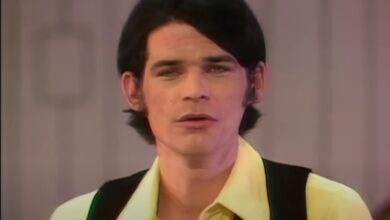Patsy Cline’s “I Fall to Pieces” – The Song That Cemented Her as a Country-Pop Icon in 1961
When I Fall to Pieces was released in 1961, it wasn’t just another country ballad—it was the moment Patsy Cline’s voice transcended genre boundaries and made her a household name. The song, written by Hank Cochran and Harlan Howard, perfectly captured the sorrow and vulnerability of lost love, wrapped in a lush, polished arrangement that bridged the gap between traditional country and the burgeoning Nashville Sound. I Fall to Pieces became Cline’s first No. 1 hit on the Billboard Hot Country Singles chart and crossed over to the pop charts, reaching No. 12 on the Billboard Hot 100—a remarkable feat for a country artist at the time. With its soaring melody and Cline’s rich, emotive delivery, the song remains one of the defining moments in country music history.
By the early 1960s, Patsy Cline had already made a name for herself with Walkin’ After Midnight, a 1957 hit that hinted at her potential to cross into mainstream pop. Born in 1932 in Winchester, Virginia, Cline’s rise wasn’t immediate—she spent years performing in honky-tonks and making radio appearances before getting her big break. Unlike many of her contemporaries, she possessed a voice that was equal parts country twang and smooth crooner elegance, allowing her to appeal to both rural and urban audiences. What truly set her apart, however, was the raw emotional depth she brought to her performances. Her ability to make every lyric feel personal turned even the simplest songs into heart-wrenching narratives.
The story behind I Fall to Pieces began with songwriters Hank Cochran and Harlan Howard, two of the most respected figures in country music. Cochran first played the song for Howard’s wife, country singer Jan Howard, but she felt it wasn’t right for her. The song eventually made its way to Cline through producer Owen Bradley, who recognized its potential to showcase her rich, expressive voice. Initially, Cline wasn’t enthusiastic—she was used to more uptempo numbers and had concerns about the song’s pop-influenced arrangement. However, Bradley, a pioneer of the Nashville Sound, convinced her to record it, and the result was nothing short of magic.
The recording of I Fall to Pieces took place in late 1960 at Bradley’s Quonset Hut Studio in Nashville. Bradley, who had been shaping country music’s evolution by incorporating orchestration and background vocals, gave the song a sophisticated, crossover-friendly arrangement. The use of smooth backing harmonies by The Jordanaires (best known for their work with Elvis Presley) and the restrained yet evocative pedal steel guitar created a perfect balance between traditional country storytelling and the sleek production values of pop. Cline’s vocal delivery was the final, essential ingredient—her voice soared effortlessly through the verses, capturing both the resignation and quiet devastation of the lyrics.
Upon its release in early 1961, I Fall to Pieces initially struggled to gain traction. Many country radio stations were hesitant to embrace its pop-leaning production, while pop stations were wary of its country origins. However, the song’s undeniable quality and Cline’s growing reputation led to a slow but steady climb up the charts. By August, it reached No. 1 on the Billboard Hot Country Singles chart, staying there for two weeks, and it spent a remarkable 39 weeks on the charts overall. The song’s crossover appeal helped it reach No. 12 on the pop charts, a rare accomplishment for a country singer at the time.
Beyond its chart success, I Fall to Pieces had a lasting impact on country music’s place in the mainstream. It was one of the key records that solidified the Nashville Sound, a style that would dominate country music throughout the 1960s and beyond. The song proved that country music could have sophisticated, polished production without losing its emotional core. It also demonstrated that female artists could achieve major crossover success in a male-dominated industry, paving the way for future stars like Dolly Parton, Linda Ronstadt, and Reba McEntire.
For Patsy Cline, I Fall to Pieces was a career-defining moment. It established her as a leading lady of country music and opened doors for her to perform on national television, including The Ed Sullivan Show and American Bandstand. The song’s success also gave her more creative control over her material, allowing her to further explore the fusion of country and pop sounds in later hits like Crazy and She’s Got You. Tragically, just two years after the song’s release, Cline’s life was cut short in a plane crash in 1963, but by then, she had already left an indelible mark on the industry.
The influence of I Fall to Pieces extended well beyond Cline’s career. It became a template for countless country ballads that followed, inspiring artists to embrace orchestral arrangements and lush harmonies. The song has been covered by numerous artists across genres, including Loretta Lynn, Linda Ronstadt, and LeAnn Rimes, each bringing their own interpretation to its timeless theme of heartbreak. Even today, the song’s melody and structure continue to influence modern country-pop crossovers.
Perhaps one of the most poignant aspects of I Fall to Pieces is how it intertwined with Patsy Cline’s personal story. In 1961, just months after the song became a hit, Cline was involved in a near-fatal car accident that left her with severe injuries. As she recovered, fellow country star Dottie West played the song for her, and Cline reportedly said, “Isn’t it something how the song fits my life right now?” This eerie parallel between art and reality added to the song’s mystique, making it even more poignant for her fans.
Decades after its release, I Fall to Pieces remains one of the most celebrated songs in country music history. It has been inducted into the Grammy Hall of Fame, included in Rolling Stone’s lists of greatest songs, and continues to receive airplay on classic country stations. More importantly, it stands as a testament to Patsy Cline’s unparalleled ability to convey emotion through song.
The impact of I Fall to Pieces helped shape the direction of country music, proving that blending country’s raw emotion with pop’s polished production could create something truly special. It paved the way for the genre’s evolution into what would later be known as “countrypolitan,” a style that artists like Glen Campbell, Tammy Wynette, and Kenny Rogers would adopt in the following decades.
Even today, I Fall to Pieces resonates with listeners, its message of heartache and longing as powerful as ever. Patsy Cline’s voice, full of both vulnerability and strength, ensures that the song will never fade into obscurity. It remains a masterpiece of storytelling, a landmark in country music’s crossover history, and a lasting tribute to one of the greatest vocalists of all time.



